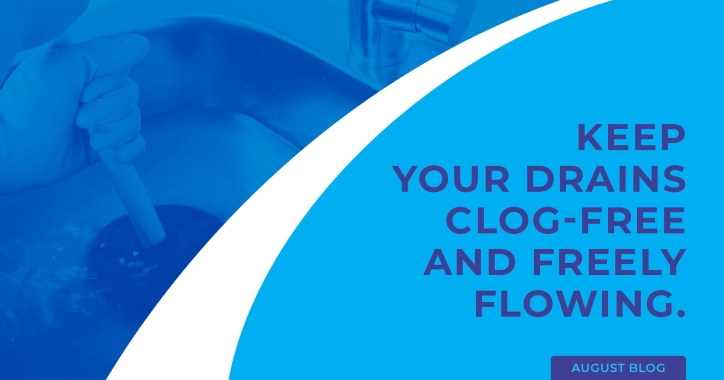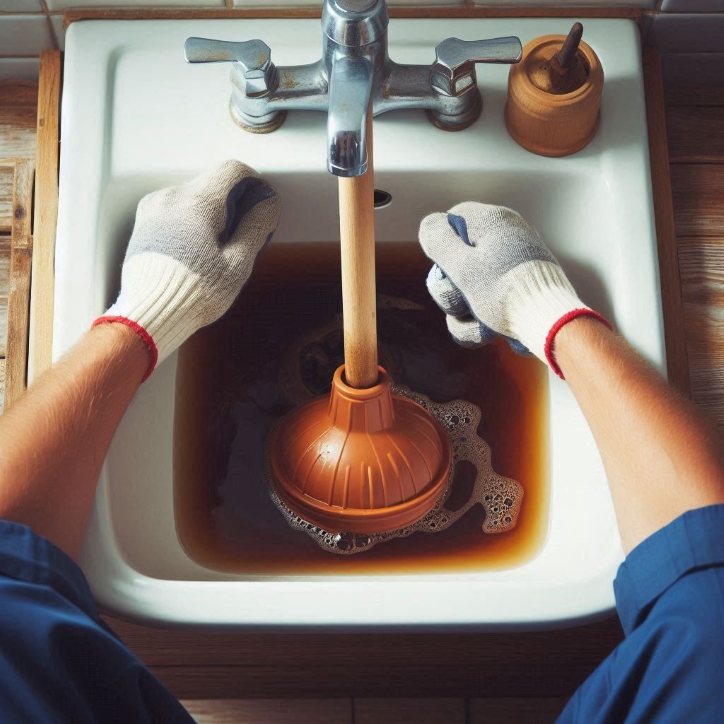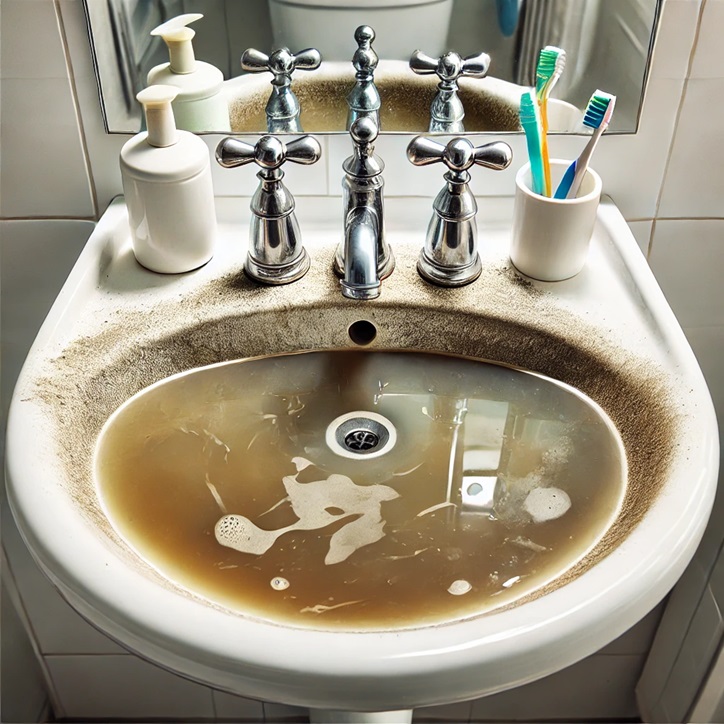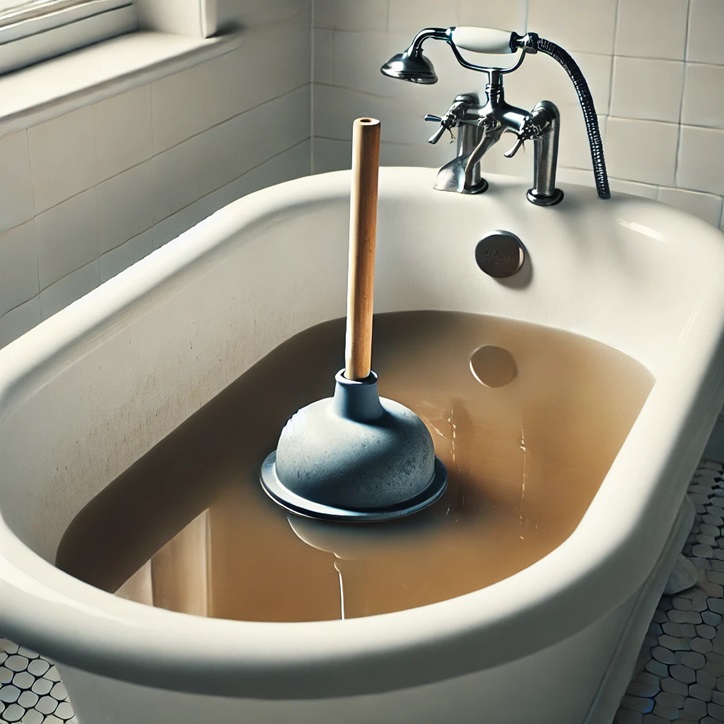
Keep your clogged drain freely flowing. Common causes and how to prevent drain clogs.
Let’s talk stoppages. Every home has them. Every homeowner dreads them. No matter how old or new your home is, everyone will run into a clogged drain or toilet at some point in their life. In a best-case scenario, an old trusty plunger can resolve the issue, and in a worst case scenario you are calling in the plumbing services experts after giving it your best effort without resolve. Today we will discuss typical stoppages you can expect in a home, how to unclog them, when to call in the experts, and how to prevent them from happening in the future.
Kitchen Sink Clogs
First, let’s start in the kitchen. Referred to as the “heart of the home”, it is estimated that people spend an average of 1-hour per day in the kitchen. In a larger family, that number is even higher. If you read our recent post about garbage disposal dos and don’ts, you know that not everything is meant to be disposed of down the kitchen drain. However, even if you are following all the rules to ensure your garbage disposal stays in tip-top shape, a clogged drain can still happen to the best of us. So, it is no surprise that a clogged sink will naturally occur over time. Here are a few common causes of kitchen sink clogs:
the home”, it is estimated that people spend an average of 1-hour per day in the kitchen. In a larger family, that number is even higher. If you read our recent post about garbage disposal dos and don’ts, you know that not everything is meant to be disposed of down the kitchen drain. However, even if you are following all the rules to ensure your garbage disposal stays in tip-top shape, a clogged drain can still happen to the best of us. So, it is no surprise that a clogged sink will naturally occur over time. Here are a few common causes of kitchen sink clogs:
- Food particles, grease, and fat: starchy, fibrous foods, and coffee grinds can get stuck in the pipes and create a blockage over time. While grease and fat can solidify in the pipes, creating a barrier to prevent water flow.
- Foreign objects: small objects like jewelry, toys, utensils or other small household items can fall down the drain and create blockages.
- Soap scum: residue from soap that is mixed with hard minerals in the water can create buildup in pipes over time.
- Hair: although more common in bathroom drains, hair that is washed down the drain can get stuck in the pipe and attach itself to the walls and other debris.
- Tree roots: while more common in older homes, tree roots can grow inside underground pipes through small cracks in sewer lines creating blockages.
Bathroom Sink Clogs
Next stop, the bathroom. While people do not spend as much time in the bathroom as they do in the kitchen, it is still an equally important modern-day luxury that should not be taken for granted. Here are a few common causes of bathroom sink and shower drain clogs that can easily occur over time:

P-trap: under the bathroom sink is a bend in the pipe called the “P-trap” that prevents sewer gas from coming up through the sink. Due to its shape, debris and small objects can easily get trapped resulting in blockages and standing water.
- Age of Plumbing: if your home is older or your plumbing has not been updated in many years, it is possible that your pipes have corroded or rusted due to age or usage over time. This can lead to excess buildup and blockages.
- Soap scum: similar to the kitchen, residue from soap that is mixed with hard minerals in the water can wreak havoc on drain pipes and create buildup over time. This can occur in both the shower and bathroom sink drains.
Hair: the most common cause of clogs in the bathroom is hair buildup. As it goes down the drain it clumps and gets stuck to the walls of the pipes creating a barrier and blockages.
Bathroom Toilet Clogs
Another common issue that many homeowners, and occupants in general, face in the bathroom, is toilet stoppages. In addition to common causes that most people are familiar with like using too much toilet paper, little Bobby’s hot wheels falling into the toilet, etc, there are other reasons that your toilet may not be performing at its best. Here is a list of basic dos & don’ts to ensure your toilet continues flowing and flushing as it should:
- Don’t flush grooming products like makeup wipes, q-tips, cotton balls, etc., down the toilet.
- Don’t use chlorine or other sanitizing tablets in the tank as it can damage the flapper and prevent it from flushing properly.
- Don’t flush personal hygiene items down the toilet like sanitary napkins, floss, diapers, etc. Flushable wipes are acceptable- but use only sparingly. Make sure you distinguish between wipes that can be flushed and wipes that cannot be flushed.
- Do retrieve any objects that could clog the toilet prior to flushing that are accidentally dropped in the toilet (i.e. Bobby’s hot wheels).
- Do conduct a dye test if you suspect your toilet has a leak to see if the dye shows up in the toilet bowl. Click here to watch a video on how to conduct a dye test.
- Do clean your toilet regularly with the appropriate cleaner to prevent buildup
- Do check the flapper on occasion to ensure it is sealing properly. If the flapper is bad this will affect flushing.
- Do check the water level and adjust to the appropriate height.
Clearing the Clogs
Now that you know the reasons that clogged sinks, drains, and toilets occur, and what to do and not to do in the future, here are a few things you can try to clear the stoppages when a situation arises:
- Garbage Disposal: If the stoppage is in the kitchen, check your garbage disposal to ensure it is working properly. Read our latest blog on the do’s and don’ts of using your garbage disposal the right way.
- Plunger: Fill your sink with 3-4 inches of water,
 then use a plunger over the clogged drain for 30 seconds. Run water to see if the clog is starting to clear. Repeat this process until the water is fully draining down the sink.
then use a plunger over the clogged drain for 30 seconds. Run water to see if the clog is starting to clear. Repeat this process until the water is fully draining down the sink. - Baking Soda and Vinegar: Pour about 1 cup of baking soda into the sink drain. Wait a few minutes and then pour 1 cup of white vinegar on top of the baking soda. The baking soda/vinegar reaction will loosen any clogs in the drain. Wait 2 hours and then run hot water down the drain.
- Drain Snake: A drain snake is used to reach deep clogs in drains or toilets. Its corkscrew-type spring removes clogs and allows water to flow.
- Clear the Trap: Your kitchen or bathroom sink will have either a u-shaped trap or p-trap. Both are magnets for clogs due to the bend in their shape. The traps should be taken apart and cleared of any debris or buildup that is causing stoppages.
- Drain Cleaning: professional drain cleaning is a service that clears blockages and debris from drains and pipes. It improves water flow, prevents backups, and reduces odors.
Main Drain Line Stoppages
While this list will be the common cause of your drain or toilet stoppages the majority of the time, on occasion there is a deeper underlying issue that will continue to cause clogs over and over again. If this happens, this should be a red flag that a bigger issue exists, and it is time to call a professional. Repeated clogs as well as basement drain backups usually point to a city sewer line or septic tank issue.
Blockages in the main sewer line can occur for a variety of reasons including tree root infiltration, lint from washing machines, hair, baby wipes, feminine products, toilet paper, paper towels, etc. When water cannot flow out through the main drain lines, the interior home drains will be impacted as well. If this is happening, contact a plumbing specialist today for a thorough inspection of your main sewer line.
We understand that clogged drains and toilets can be frustrating. If you need assistance clearing the stoppages or you would like to discuss our Drain Cleaning services, Blue Chip Plumbing is just one phone call away. Contact us here or give us a call today at (513) 999-6820 to speak to a plumbing specialist and get a free quote on any of our services.

